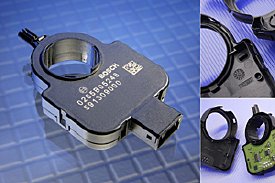Feb 4 2008
The steering-angle sensor that Bosch produces for various renowned international car manufacturers is now being made of Ultradur® High Speed, BASF’s very easy-flowing PBT. This plastic allows injection molders not only to markedly shorten the cycle times, but also to make their components with an even more filigree design. The steering-angle sensor plays an integral role in the safety of vehicles and provides the electronic stability program (ESP) with information about the position of the steering wheel. This is why this part and its electronics are located directly on the steering column.

The latest generation: thin-walled and laser-writable
Following the first sensor generation made of Ultradur B4300 G4 LS High Speed (20% glass fibers), Bosch recently went into serial production with its newly developed sensor for the latest generation of automobiles. In view of the ever-growing requirements being made in terms of space, the new steering-angle sensor had to have even thinner walls and an even more filigree construction than its predecessor. When standard PBT is used, only one-third of the intricate injection-molding tool can be filled. In contrast, with the easy-flowing Ultradur High Speed, whose good processing properties are due to BASF’s specially devised nanotechnology, the sensor can be manufactured without any problems.
Moreover, the steering-angle sensor made of this plastic can be laser-written with a high degree of contrast, so that the parts can be marked with very fine so-called data matrix codes containing a wealth of information about the part on a very small surface area. Since the material can replicate details very precisely, thereby adhering to Bosch’s narrow tolerances, the sensor can be configured very flexibly, depending on the car model and on the desired functionality. This BASF PBT has also successfully made the transition from screw-in to snap-on connections.
Posted February 4th , 2008